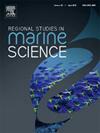与西西里岛(爱奥尼亚海)附近珊瑚堆积有关的生物多样性
IF 2.1
4区 环境科学与生态学
Q3 ECOLOGY
引用次数: 0
摘要
珊瑚礁是地中海最重要的栖息地之一,具有极高的生物多样性,但尚未得到充分研究。本文研究了在 Marzamemi(西西里岛东南部,爱奥尼亚海)36.7 米深处采集的珊瑚生物构造的生物多样性。对主要相关分类群的物种多样性、组成和结构进行了调查,以确定硬框架(主要由钙化珊瑚虫构建)和冠层覆盖的群落之间可能存在的差异。经研究发现,几乎所有群落的物种多样性都很丰富。毛环节动物是种类最丰富的类群,与有孔虫一起也是冠层和框架上最丰富的类群。其他类群在冠层上的物种多样性(蛇形目除外)和总丰度(软体动物除外)都比在框架上高。由于其性质和微环境参数不同,冠层和框架上的群落也不同。除了幼体标本外,冠层上大多栖息着未矿化和弱矿化、体型小、寿命短的物种,这些物种非常适合生活在短暂而灵活的基质上。与此相反,坚硬而持久的骨架上大多栖息着矿化度高、体型大、寿命长的物种,它们通常有助于构建和加强生物结构。与绘图和监测不同,由于一些物种体积小、行为隐蔽,要彻底描述珊瑚生物多样性,需要准确的肉眼和显微镜分析,并辅以扫描电镜调查。本文章由计算机程序翻译,如有差异,请以英文原文为准。
Biodiversity associated with a coralligenous build-up off Sicily (Ionian Sea)
Coralligenous is one of the most important habitats of the Mediterranean Sea hosting a very high biodiversity that, however, has not been fully investigated yet. The paper addressed the study of the biodiversity of a coralligenous bioconstruction collected at a depth of 36.7 m off Marzamemi (SE Sicily, Ionian Sea). The species diversity, composition and structure of the main associated taxonomic groups were investigated in order to identify possible differences between the communities of the hard framework (mainly built by calcified corallinales) and the canopy cover. The examined build-up showed significant species diversity for almost all groups. Bryozoans were the most diversified group and, together with foraminifers, also the most abundant both on the canopy and the frame. Further groups showed high species diversity (except for serpulids) and total abundance (except for molluscs) on the canopy rather than on the frame. Due to their different nature and microenvironmental parameters, the canopy and the frame hosted different communities. Besides juvenile specimens, the canopy mostly hosted unmineralized and weakly mineralized, small-sized, short-lived species well adapted to living on ephemeral and flexible substrates. On the contrary, the rigid and persistent frame mostly hosted highly mineralized, large, long-lived species, which usually contributed to the building and strengthening of the bioconstruction. Unlike mapping and monitoring, a thorough description of coralligenous biodiversity requires accurate naked eye and microscopical analysis assisted by SEM investigation due to the small size and cryptic behaviour of several species.
求助全文
通过发布文献求助,成功后即可免费获取论文全文。
去求助
来源期刊

Regional Studies in Marine Science
Agricultural and Biological Sciences-Ecology, Evolution, Behavior and Systematics
CiteScore
3.90
自引率
4.80%
发文量
336
审稿时长
69 days
期刊介绍:
REGIONAL STUDIES IN MARINE SCIENCE will publish scientifically sound papers on regional aspects of maritime and marine resources in estuaries, coastal zones, continental shelf, the seas and oceans.
 求助内容:
求助内容: 应助结果提醒方式:
应助结果提醒方式:


